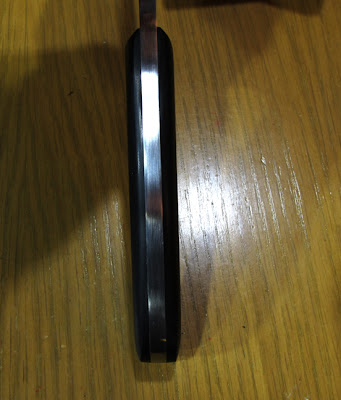Before I get too far:
Happy New Year!
May the New Year find you healthy and happy. If you have those two you are truly wealthy.
Now, let’s jump into knife stories.
I typically carry folders.
That’s not to say I don’t like
fixed blades. I do. It's just in the urban environment most fixed
blades tend to alarm the rabbit people.
I like to keep a low profile. If
there is trouble I want to slip away before it gets to me, so not being on the
forefront of anyone’s cerebrum is good.
In my collection, and I’ve been known
to carry and use them, are three of my favorite fixed blades.
 |
| From left to right: S&W's HRT, the Gerber MKI and Livesay's Woo |
The first is the classic Gerber MK I, a double-edged
dagger. Gerber introduced this fighting
knife in 1976, but had to call it a survival knife so they could sell it on military
bases. Wouldn’t want those men going
overseas to fight to own a fighting knife.
Who knows, maybe fightin’ knife sounds un-American?
Mine’s a black blade. I purchased it
sometime after 1984. The blade is
described as a high carbon surgical steel with a Rockwell C hardness of 58. Unfortunately Gerber didn’t keep track of the
serial number as well as they did with the MK II.
I’ve got to admit as a camping or
survival knife, it’s the pits. Every
time I carry it I have to remember not to push on the back of the blade with my
palm to get extra force on it.
I bought the S andW HRT at the
famed Knob Creek Machine Gun Shoot. The
shoot is just one giant excuse to spend money.
(I loved every moment there!) Oh, and how you can spend it. At the time
$50 would let you shoot 50 rounds of .50 cal BMG ammo from a machine gun. You didn’t even get to keep the fired
brass. So I bought a knife. Cheaper, and I walked away with it.
It looks a little like Gerber’s Guardian,
but to avoid any legal complications the 3.5 inch dagger-like blade is
sharpened only on one side. The other
side is tapered to a nice rounded edge.
It wouldn’t take much to sharpen that edge, but the blade’s thinness
would leave very little metal behind the point.
I’d think twice about sharpening the false edge.
The blade locks in a molded plastic
sheath that secures the knife upside down.
Unfortunately the belt clip isn’t reversible or removable. At least not removable more than once. You can cut it off and then lash the sheath
anywhere you want. I’d keep the belt
clip. It’s nice to have options.
in China and it’s called the HRT. Do you really think that after the FBI’s
Hostage Rescue Team is outfitted with $2000 handguns the agents then carry $14
knives? If so, please contact me. I have
a option on an uranium mine I want to talk to you about.
Still I like its looks, and 3.5
inches of sharp steel can get me in more trouble I would want.
It’s a bare bones 7.5-inch long tanto
neck knife made from 1095 steel. The
blade is a 3.25-inch high chisel grind that makes for easy care and resharpening.
Once upon a time there was a cable
show called SOF or something like that.
Almost every program featured a scene with a main character needing his
neck knife, his Newt Livesay neck knife. Needless to say, they were HOT! with the civilian tactical crowd.
I use to sell the Woo along with
two other neck knives from him. The
initial order was under $500 and that made you an authorized dealer.
Now, Newt was the knife maker, but
his daughter was the business manager.
After the cable show was terminated with extreme prejudice, sales of
these knives cooled off. So I thought
I’d carry a few of his other fixed blades.
After all, I’d been an authorized dealer for at least two years and
bought a lot of those knives.
Not so
fast college boy….The daughter insisted I do another buy-in of $1000 to be an
authorized dealer. That was the end of that.
Despite having a noose with a
breaking strength of 500 pounds around my neck making me nervous, I liked the
idea of a bare bones knife tucked safely away under my shirt. The knife was lightly parkerized to resisted
rust. The straight-edge tanto is easy
to sharpen. It’s a nice knife. It reminds me of the knife the government agent
carried in “Death of a Citizen.”
(PS: Take a look at the price on that paperback: 25 cents...!)
Oh yeah, she lasted about 3 paragraphs before Matt Helm
found her dead. I’m going to think on
that.







